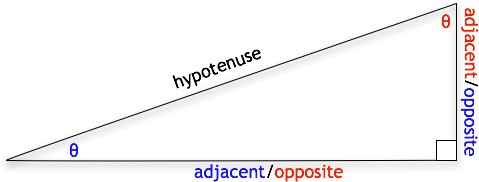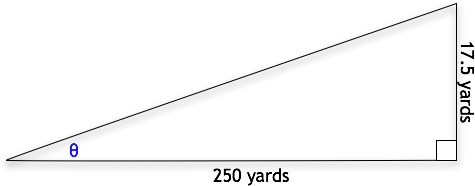 While baseball may be a game of inches, golf, it’s been said, is a game of angles. It’s better to approach Augusta National’s 11th green from the far left edge of the fairway than, say, what used to be the far right edge of the fairway. It’s better to leave yourself an uphill putt than a downhill putt. If you play a fade, you’re better off teeing up on the right-hand side of the teebox.
While baseball may be a game of inches, golf, it’s been said, is a game of angles. It’s better to approach Augusta National’s 11th green from the far left edge of the fairway than, say, what used to be the far right edge of the fairway. It’s better to leave yourself an uphill putt than a downhill putt. If you play a fade, you’re better off teeing up on the right-hand side of the teebox.
Yes, in addition to being a mental exercise, a stroll in the park, and one of the few solitary sports in the world, golf is a game of angles. This week in The Numbers Game we take a look at some of those angles: how far offline can you start a three-foot putt and still expect to make it? How about a ten-foot putt? How hard is it to hit the green or fairway?
Let’s find out.
Sohcahtoa
Virtually all the math in this edition of The Numbers Game is going to involve right triangles, and Sohcahtoa can help. Sohcahtoa is not an Indian name, but a mnemonic device to help you remember how the math works in calculating angles and lengths of right triangles. What’s a right triangle? Well, it’s a triangle in which one of the angles is “right” – perpendicular or 90°.

In this right triangle, I’ve marked two angles and color-coded their adjacent and opposite sides. The hypotenuse is always the longest side.
If you know two things – an angle (θ) and a length or two lengths – you can calculate the other angles. After all, one of the angles is a given: 90°. The “o,” “h,” and “a” in “Sohcahtoa” stand for “opposite,” “hypotenuse,” and “adjacent.” The other letters correspond to sin, cosine, and tangent:
SOH – sin(θ) = opposite/hypotenuse
CAH – cos(θ) = adjacent/hypotenuse
TOA – tan(θ) = opposite/adjacent
This is all we’ll need to do today’s calculations. Let’s get started.
From the Tee
The average fairway width at most golf courses is approximately 35 yards. The U.S. Open sets its fairways to 22-28 yards in width, and I have a hole at my course – a par five no less – that features a fairway measuring only 17 yards wide.
How accurate does one have to be from the tee to find the fairway with a 250-yard drive? Let’s see:

I will not be drawing the triangles to scale, so please ignore the fact that the 17.5-yard side is about a third as large as the 250-yard side.
In this example (and all others to follow), we cut the width of the target in half. A miss five yards to the right is the same as five yards to the left in terms of angle, so we’ll be expressing the range of angle as a +/- number. The actual angular range is thus double the maximum angle itself.
Every example in this article will use a triangle similar to the one above. Since we have the opposite and adjacent sides for the given angle, the TOA portion of Sohcahtoa becomes relevant: tan(θ) = opp/adj. Plugging in our actual numbers, we get:
tan(θ) = 17.5/250 = 0.07
Solving for theta (θ) yields 4.004°. So, to hit a 35-yard wide fairway, a golfer has a “safety zone” of +/- 4°. If he pulls or pushes his drive by more than these 4°, he’ll find himself in the rough.
How does the angle change on a wider – or narrower – fairway? This chart shows the results:
Drive Width tan(θ) θ (+/-) ----- ----- ------ ------- 250 17 0.03 1.95 250 20 0.04 2.29 250 25 0.05 2.86 250 30 0.06 3.43 250 35 0.07 4.00 250 40 0.08 4.57 250 45 0.09 5.14 250 50 0.10 5.71 250 65 0.13 7.41 250 80 0.16 9.09 250 100 0.20 11.31
You’ll notice (for example, with the 20/40/80 trio) that as the fairway width doubles, so too does the angle. This makes sense, given that we’re using a simple fraction (20/250, 40/250, 80/250) to calculate.
Tiger’s Driving
Much has been made of Tiger’s inability to find the fairway, but the simple truth is that it’s tougher to find the fairway 300 yards from the tee than it is 200 yards from the tee. How much harder? Let’s re-run the calculations, this time keeping the fairway width at 28 yards (the average fairway width on the PGA Tour, and a smaller fairway than you’re likely used to hitting to) and changing the drive’s yardage. Doing so, we get:
Drive Width tan(θ) θ (+/-) ----- ----- ------ ------- 200 28 0.0700 4.00 210 28 0.0667 3.81 220 28 0.0636 3.64 230 28 0.0609 3.48 240 28 0.0583 3.34 250 28 0.0560 3.21 260 28 0.0538 3.08 270 28 0.0519 2.97 280 28 0.0500 2.86 290 28 0.0483 2.76 300 28 0.0467 2.67
Again, since we’re just using a simple ratio, at 300 yards Tiger must be 33% more accurate with his drive than someone who drives the ball 200 yards. Mixing the results, Tiger must also be about 34% more accurate than someone playing to a 35-yard wide fairway with a 250-yard drive.
Finally, if Tiger tries to hit one 350 to a fairway 28 yards wide, his angle comes out to 2.29°, or about 43% more accurate than your 250-yard drive on a 35-yard wide fairway.
Approach Shots
Imagine a rectangular green 25 yards wide, or 75 feet edge to edge. The depth is irrelevant – we’re going to be shooting at the flag. How accurate must your approach shot be to find a piece of the green?
Appr. Width tan(θ) θ (+/-) ----- ----- ------ ------- 50 25 0.2500 14.04 75 25 0.1667 9.46 100 25 0.1250 7.13 115 25 0.1087 6.20 130 25 0.0962 5.49 150 25 0.0833 4.76 175 25 0.0714 4.09 200 25 0.0625 3.58 225 25 0.0556 3.18
In other words, from 50 yards out, your shank is still not going to find the green – you have only +/- 14°. From 225, perhaps trying to reach a par-five green in two with a 3-wood or hybrid, that angle decreases to only +/- 3.18°. If you found a 35-yard fairway with your 275 yard drive (+/- 3.65°), you’ll have to be even more accurate trying to reach the green.
Putting
A 25-yard green is going to look awfully big compared to a 4¼-inch hole!
For the purposes of examining putting, we’re clearly going to have to ignore lip-outs. The math here essentially assumes that every putt is struck the exact firmness to stop at the exact center of the hole. This has the effect of making the hole play as wide as possible, as a ball that is inside the hole by a millionth of an inch will still be made.
For the purpose of this chart, the Putt length is listed in feet and the hole size is listed in inches. Conversion is done prior to the calculation of θ.
Putt Hole tan(θ) θ (+/-) ---- ---- ------ ------- 1 4.25 0.1771 10.04 3 4.25 0.0590 3.38 5 4.25 0.0354 2.03 10 4.25 0.0177 1.01 15 4.25 0.0118 0.68 20 4.25 0.0089 0.51 25 4.25 0.0071 0.41 30 4.25 0.0059 0.34 50 4.25 0.0035 0.20 100 4.25 0.0018 0.10
While you may find the generosity of missing your intended line on a one-foot putt by +/- 10°, the odds of making even a five-footer seem stacked against you. You have only a margin of +/- 2.03° – again, with absolutely perfect speed – to make the putt.
Dave Pelz is famous for saying thatt putts should be struck firmly enough travel 17 inches by the hole if they miss. I’m going to guess that this effectively makes the hole about 3½ inches wide – anything that catches the outer 3/8″ of the hole is not going to go in at that speed. A putt struck this firmly will only fall into the hole if it hits the middle 2.3 inches! With this little correction in mind, the putting chart becomes really daunting.
Putt Hole tan(θ) θ (+/-) ---- ---- ------- -------- 1 2.3 0.09583 5.474 3 2.3 0.03194 1.830 5 2.3 0.01916 1.098 10 2.3 0.00958 0.549 15 2.3 0.00639 0.366 20 2.3 0.00479 0.275 25 2.3 0.00383 0.220 30 2.3 0.00319 0.183 50 2.3 0.00192 0.110 100 2.3 0.00096 0.055
Want to make a 100-foot putt? You’d better get the line right – down to +/- 0.055° – with near-perfect speed. With these numbers, you’ve gotta wonder how we ever make even a three-foot putt let alone the occasional putt from ten feet.
Golf is a Hard Game
I used to get pretty down on myself when playing poorly. A few years back I thought of something.
Imagine telling someone who has never heard of golf that you’ve invented a sport that involves hitting a ball with oddly shaped sticks into a teeny little hole placed 400 yards away. How many times, you could ask the person, do they think you’d have to hit the ball to achieve the goal. 50? 100?
The fact that we can get the ball into the hole in even eight strokes – let alone four, three, or even two on rare occasion – is a true testament to how good we really all are at golf. So, the next time you’re furious about your 85, think back to this article and the little story above. It may not improve your game, but it does offer a little consolation.

Very interesting numbers. We just had a conversation this weekend while watching the Players about “everything” that goes into making a great shot. If you take into consideration – the wind, club, swing, contact (angle, good, etc…), green or landing area, etc… These angles start to break some of that down.
Tiger’s lack of fairway hitting is better explained with these calc’s. At 300 yds the importance of angle is so great.
A great perspective, but I would still love to hit a 300 yard drive sometime. Given the controversy on how far PGA players hit the ball, how do you think course designers should react to this information?
Very nice article, I have already shared it with several people. It’s no wonder golf is such a difficult game. Although I can find no solace in the fact that flunking geometry in high school has indirectly contributed to the fact I cannot putt! 😉
Very good even if incredibly daunting info, Erik. Reminds me of a story I’m probably repeating, but it’s so germane here goes:
I was doing a video at the USGA test center some years ago for Frank Thomas and his crew. The guy responsible for ball testing with Iron Byron was not a golfer, but an engineer of some repute. Over time the steel shafts in the drivers they were using would fatigue and break. When they did it took him hours to replace the club and recalibrate Iron Byron to duplicate the speed and launch conditions needed for the test.
Dealing with a perfect machine and measurable parameters, and being an engineer to boot who understood the physics and variables involved, he was quick to declare that the skill displayed by professionals were inexplicable and impossible. If a perfect machine couldn’t replicate perfection, how could mere humans?
Which I guess goes to your point, Erik, that we are all better than we might imagine.